An Integrated GIS and Machine-Learning Technique for Groundwater Quality Assessment and Prediction in Southern Saudi Arabia
Abstract
1. Introduction
2. Materials and Methods
2.1. Study Area Description
2.2. Dataset Collection
2.3. Water Quality Index (WQI)
2.4. Machine Learning Methods
2.4.1. Multiple Regression
2.4.2. Artificial Neural Network (ANN)
2.4.3. Support Vector Machines (SVM)
2.4.4. Fit Binary Tree
| Algorithm 1. Pseudocode recursively for the BST search method. |
| Tree-Search(x, key) if x = NIL or key = x.key then return x if key < x.key then return Tree-Search(x.left, key) else return Tree-Search(x.right, key) end if |
2.4.5. Gaussian Process Regression (GPR)
2.5. Evaluation Indicators
3. Results and Discussion
3.1. Hydrogeological Aspects
3.2. Statistical Analysis
3.3. Chemical Analysis, Spatial Distribution, and Correlation Coefficients
3.4. Water Quality Index Distribution and Classification
3.5. Evaluation of Data-Driven Models in WQ Prediction
3.6. Best Subset Regression for Selecting the Most Important Parameters
4. Conclusions and Outlook
- -
- Higher levels of Cl− and SO42− were found near the coast, which is indicative of seawater intrusion and serves as a proxy for salinisation. Furthermore, seven wells had a WAWQI of more than 300, suggesting that the water is unsafe for human consumption.
- -
- The results of the stepwise fit model revealed that pH, K+, and NO3− are the most important variables, while HCO3− is a non-significant variable. The best results were obtained from the simulated ANN modeling for the nine-neuron network after 19 iterations, whereas the best validation performance was 0.048016 at iteration 13.
- -
- The GPR, linear regression (Stepwise), and ANN models worked flawlessly during the training and testing stages, with a high correlation of 1 and low statistical errors.
- -
- The linear regression (stepwise) model generated the best results, with MAE = 0.0023, RMSE = 0.0028, and R = 1.0. This good performance is due to its special mechanism with repeated regressions, each time deleting the weakest associated variable until the observed and measured values fully match. The ANN model came in second with MAE = 0.088, RMSE = 0.0884, and R = 1.0. The GPR model finished in third with MAE = 0.194, RMSE = 0.255, and R = 1.0. The SVM (Linear) model was next, with MAE = 3.39, RMSE = 3.83, R = 0.9988.
- -
- The SVM (polynomial kernel) and Fit binary tree models performed the worst during the training and testing phases of the prediction procedure.
- -
- The optimum input combination for WAWQI model prediction was the eight input combinations with high R2 (from 0.975 to 1.00) and high Adj-R2 (from 0.974 to 1.00).
Author Contributions
Funding
Data Availability Statement
Acknowledgments
Conflicts of Interest
Abbreviations
| AdaBoost | Adaptive Boosting |
| AI | Artificial Intelligence |
| ANN | Artificial Neural Network |
| APHA | American Public Health Association |
| AR | Additive Regression |
| BRBP | Bayesian Regularisation Back Propagation |
| BST | A Binary Search Tree |
| Ca2+ | Calcium Ion |
| CCMEWQI | Canadian Council of Ministers of the Environment Water Quality Index |
| Cl− | Chlorine Ion |
| GA | Genetic Algorithms |
| GIS | Geographic Information System |
| GPR | Gaussian Process Regression |
| HCO3− | Bicarbonate Ion |
| IDW | Inverse Distance Weighted |
| IWQ | Irrigation Water Quality |
| K+ | Potassium Ion |
| kNN | K-Nearest Neighbour |
| LSTM | Long Short-Term Memory |
| LWLR | Locally Weighted Linear Regression |
| MAE | Mean Absolute Error |
| MAPE | Mean Absolute Percentage Error |
| ME | Mean Error |
| Mg2+ | Magnesium Ion |
| ML | Machine Learning |
| MLR | Multiple Linear Regression |
| MLR | Multi-Linear Regression |
| Na+ | Sodium Ion |
| NO3− | Nitrate Ion |
| NSFWQI | National Sanitation Foundation Water Quality Index |
| OWQI | Oregon Water Quality Index |
| pH | Potential Of Hydrogen |
| Poly kernel | Polynomial Kernel |
| R | Coefficient of Correlation |
| RF | Random Forest |
| RMSE | Root Mean Square Error |
| R-squared | Coefficient of Determination |
| RSS | Random Subspace |
| RSS | Random Subspace |
| SGD | Stochastic Gradient Descent |
| SO42– | Sulfate Ion |
| St. Dev. | Standard Deviation |
| SVM | Support Vector Machine |
| TDS | Total Dissolved Solids |
| TH | Total Hardness |
| WAWQI | Weighted Arithmetic Water Quality Index |
| WHO | World Health Organization |
| WQI | Water Quality Index |
References
- Al-Turki, A.; Abdel-Nasser, G.; Al-Faraj, A.; Shahwan, A.; Al-Malik, A. Evaluation of well water quality in Southern Tihama plain, Saudi Arabia. Resour. Bull. 2011, 172, 5–47. [Google Scholar]
- Abdalla, F.; Al-Turki, A.; Al Amri, A. Evaluation of groundwater resources in the Southern Tihama plain, Saudi Arabia. Arab. J. Geosci. 2015, 8, 3299–3310. [Google Scholar] [CrossRef]
- Warner, K.L.; Barataud, F.; Hunt, R.J.; Benoit, M.; Anglade, J.; Borchardt, M.A. Interactions of water quality and integrated groundwater management: Examples from the United States and Europe. In Integrated Groundwater Management; Jakeman, A.J., Barreteau, O., Hunt, R.J., Rinaudo, J.-D., Ross, A., Eds.; Springer: Cham, Switzerland, 2016; pp. 347–376. [Google Scholar]
- Akinbile, C.O.; Yusoff, M.S. Environmental Impact of Leachate Pollution on Groundwater Supplies in Akure, Nigeria. Int. J. Environ. Sci. Dev. 2011, 2, 81. [Google Scholar] [CrossRef]
- Fernández, N.; Ramírez, A.; Solano, F. Physico-chemical Water Quality indices a comparative review. Bistua Rev. De La Fac. De Cienc. Básicas 2004, 2, 19–30. [Google Scholar]
- Amer, R.; Ripperdan, R.; Wang, T.; Encarnación, J. Groundwater quality and management in arid and semi-arid regions: Case study, Central Eastern Desert of Egypt. J. Afr. Earth Sci. 2012, 69, 13–25. [Google Scholar] [CrossRef]
- Ismail, E.; El-Rawy, M. Assessment of groundwater quality in West Sohag, Egypt. Desalination Water Treat. 2018, 123, 101–108. [Google Scholar] [CrossRef]
- El-Rawy, M.; Ismail, E.; Abdalla, O. Assessment of groundwater quality using GIS, hydrogeochemistry, and factor statistical analysis in Qena Governorate, Egypt. Desalin. Water Treat. 2019, 162, 14–29. [Google Scholar] [CrossRef]
- Sadat-Noori, S.M.; Ebrahimi, K.; Liaghat, A.M. Groundwater quality assessment using the Water Quality Index and GIS in Saveh-Nobaran aquifer, Iran. Environ. Earth Sci. 2014, 71, 3827–3843. [Google Scholar] [CrossRef]
- Masoud, A.A. Groundwater quality assessment of the shallow aquifers west of the Nile Delta (Egypt) using multivariate statistical and geostatistical techniques. J. Afr. Earth Sci. 2014, 95, 123–137. [Google Scholar] [CrossRef]
- El-Rawy, M.; Abdalla, F.; Negm, A.M. Groundwater Characterisation and Quality Assessment in Nubian Sandstone Aquifer, Kharga Oasis, Egypt. In Groundwater in Egypt’s Deserts; Springer: Cham, Switzerland, 2021; pp. 177–199. [Google Scholar]
- Gundaz, O.; Simsek, C. Assessment of three wastewater treatment plants in Turkey. In Wastewater Reuse–Risk Assessment, Decision-Making and Environmental Security; Springer: Dordrecht, The Netherlands, 2007; pp. 159–167. [Google Scholar]
- Usali, N.; Ismail, M.H. Use of Remote Sensing and GIS in Monitoring Water Quality. J. Sustain. Dev. 2010, 3, 228. [Google Scholar] [CrossRef]
- Akter, T.; Jhohura, F.T.; Akter, F.; Chowdhury, T.R.; Mistry, S.K.; Dey, D.; Barua, M.K.; Islam, A.; Rahman, M. Water Quality Index for measuring drinking water quality in rural Bangladesh: A cross-sectional study. J. Health Popul. Nutr. 2016, 35, 4. [Google Scholar] [CrossRef]
- Sharma, D.; Kansal, A. Water quality analysis of River Yamuna using water quality index in the national capital territory, India (2000–2009). Appl. Water Sci. 2011, 1, 147–157. [Google Scholar] [CrossRef]
- Fathi, H.; El-Rawy, M. GIS-based evaluation of water quality index for groundwater resources nearby wastewater treatment plants, Egypt. Poll. Res. 2018, 37, 105–116. [Google Scholar]
- Lumb, A.; Halliwell, D.; Sharma, T. Application of CCME Water Quality Index to Monitor Water Quality: A Case Study of the Mackenzie River Basin, Canada. Environ. Monit. Assess. 2006, 113, 411–429. [Google Scholar] [CrossRef]
- Chaturvedi, M.K.; Bassin, J.K. Assessing the water quality index of water treatment plant and bore wells, in Delhi, India. Environ. Monit. Assess. 2010, 163, 449–453. [Google Scholar] [CrossRef]
- Sharma, P.; Meher, P.K.; Kumar, A.; Gautam, Y.P.; Mishra, K.P. Changes in water quality index of Ganges river at different locations in Allahabad. Sustain. Water Qual. Ecol. 2014, 3, 67–76. [Google Scholar] [CrossRef]
- Hameed, M.; Sharqi, S.S.; Yaseen, Z.M.; Afan, H.A.; Hussain, A.; Elshafie, A. Application of artificial intelligence (AI) techniques in water quality index prediction: A case study in tropical region, Malaysia. Neural Comput. Appl. 2017, 28, 893–905. [Google Scholar] [CrossRef]
- Aldhyani, T.H.H.; Al-Yaari, M.; Alkahtani, H.; Maashi, M. Water Quality Prediction Using Artificial Intelligence Algorithms. Appl. Bionics Biomech. 2020, 2020, 6659314. [Google Scholar] [CrossRef]
- Agrawal, P.; Sinha, A.; Kumar, S.; Agarwal, A.; Banerjee, A.; Villuri, V.G.K.; Annavarapu, C.S.R.; Dwivedi, R.; Dera, V.V.R.; Sinha, J.; et al. Exploring Artificial Intelligence Techniques for Groundwater Quality Assessment. Water 2021, 13, 1172. [Google Scholar] [CrossRef]
- Prasad, D.V.V.; Kumar, P.S.; Venkataramana, L.Y.; Prasannamedha, G.; Harshana, S.; Srividya, S.J.; Indraganti, S. Automating water quality analysis using ML and auto ML techniques. Environ. Res. 2021, 202, 111720. [Google Scholar] [CrossRef]
- Ubah, J.I.; Orakwe, L.C.; Ogbu, K.N.; Awu, J.I.; Ahaneku, I.E.; Chukwuma, E.C. Forecasting water quality parameters using artificial neural network for irrigation purposes. Sci. Rep. 2021, 11, 24438. [Google Scholar] [CrossRef]
- Abduljaleel, H.Y.; Schüttrumpf, H.; Azzam, R. A GIS-Based Water Quality Management for Shatt Al-Arab River System, South of Iraq; No. RWTH-2020-09237; Lehrstuhl für Ingenieurgeologie und Hydrogeologie: Aachen, Germany, 2020. [Google Scholar]
- Setshedi, K.J.; Mutingwende, N.; Ngqwala, N.P. The Use of Artificial Neural Networks to Predict the Physicochemical Characteristics of Water Quality in Three District Municipalities, Eastern Cape Province, South Africa. Int. J. Environ. Res. Public Health 2021, 18, 5248. [Google Scholar] [CrossRef]
- Mokhtar, A.; Elbeltagi, A.; Gyasi-Agyei, Y.; Al-Ansari, N.; Abdel-Fattah, M.K. Prediction of irrigation water quality indices based on machine learning and regression models. Appl. Water Sci. 2022, 12, 76. [Google Scholar] [CrossRef]
- Wang, W.; Men, C.; Lu, W. Online prediction model based on support vector machine. Neurocomputing 2008, 71, 550–558. [Google Scholar] [CrossRef]
- Noori, R.; Safavi, S.; Shahrokni, S.A.N. A reduced-order adaptive neuro-fuzzy inference system model as a software sensor for rapid estimation of five-day biochemical oxygen demand. J. Hydrol. 2013, 495, 175–185. [Google Scholar] [CrossRef]
- Gazzaz, N.M.; Yusoff, M.K.; Aris, A.Z.; Juahir, H.; Ramli, M.F. Artificial neural network modeling of the water quality index for Kinta River (Malaysia) using water quality variables as predictors. Mar. Pollut. Bull. 2012, 64, 2409–2420. [Google Scholar] [CrossRef]
- El Bilali, A.; Taleb, A. Prediction of irrigation water quality parameters using machine learning models in a semi-arid environment. J. Saudi Soc. Agric. Sci. 2020, 19, 439–451. [Google Scholar] [CrossRef]
- Gupta, A.N.; Kumar, D.; Singh, A. Evaluation of Water Quality Based on a Machine Learning Algorithm and Water Quality Index for Mid Gangetic Region (South Bihar plain), India. J. Geol. Soc. India 2021, 97, 1063–1072. [Google Scholar] [CrossRef]
- Kulisz, M.; Kujawska, J.; Przysucha, B.; Cel, W. Forecasting Water Quality Index in Groundwater Using Artificial Neural Network. Energies 2021, 14, 5875. [Google Scholar] [CrossRef]
- El-Rawy, M.; Abd-Ellah, M.K.; Fathi, H.; Ahmed, A.K.A. Forecasting effluent and performance of wastewater treatment plant using different machine learning techniques. J. Water Process. Eng. 2021, 44, 102380. [Google Scholar] [CrossRef]
- Kouadri, S.; Elbeltagi, A.; Islam, A.R.M.T.; Kateb, S. Performance of machine learning methods in predicting water quality index based on irregular data set: Application on Illizi region (Algerian southeast). Appl. Water Sci. 2021, 11, 190. [Google Scholar] [CrossRef]
- Kouadri, S.; Pande, C.B.; Panneerselvam, B.; Moharir, K.N.; Elbeltagi, A. Prediction of irrigation groundwater quality parameters using ANN, LSTM, and MLR models. Environ. Sci. Pollut. Res. 2022, 29, 21067–21091. [Google Scholar] [CrossRef] [PubMed]
- Horton, R.K. An Index Number System for Rating Water Quality. J Water Pollut. Control Fed. 1965, 37, 300–306. [Google Scholar]
- The Climate Change Knowledge Portal (CCKP). Current Climate: Climatology. Saudi Arabia. Available online: https://climateknowledgeportal.worldbank.org/country/saudi-arabia/climate-data-historical (accessed on 13 January 2023).
- Sulaiman, A.; Elawadi, E.; Mogren, S. Gravity interpretation to image the geologic structures of the coastal zone in al Qunfudhah area, southwest Saudi Arabia. Geophys. J. Int. 2018, 214, 1623–1632. [Google Scholar] [CrossRef]
- Alshehri, F.; Sultan, M.; Karki, S.; Alwagdani, E.; Alsefry, S.; Alharbi, H.; Sahour, H.; Sturchio, N. Mapping the Distribution of Shallow Groundwater Occurrences Using Remote Sensing-Based Statistical Modeling over Southwest Saudi Arabia. Remote Sens. 2020, 12, 1361. [Google Scholar] [CrossRef]
- Alarifi, S.S.; Abdelkareem, M.; Abdalla, F.; Alotaibi, M. Flash Flood Hazard Mapping Using Remote Sensing and GIS Techniques in Southwestern Saudi Arabia. Sustainability 2022, 14, 14145. [Google Scholar] [CrossRef]
- Abdalla, F. Ionic ratios as tracers to assess seawater intrusion and to identify salinity sources in Jazan coastal aquifer, Saudi Arabia. Arab. J. Geosci. 2018, 9, 40. [Google Scholar] [CrossRef]
- APHA. Standard Methods for the Examination of Water and Wastewater, 21st ed.; American Public Health Association: Washington, DC, USA, 2005. [Google Scholar]
- WHO. Guidelines or Drinking-Water Quality, 4th ed.; World Health Organization: Geneva, Switzerland, 2011. [Google Scholar]
- Kumar, S.K.; Bharani, R.; Magesh, N.S.; Godson, P.S.; Chandrasekar, N. Hydrogeochemistry and groundwater quality appraisal of part of south Chennai coastal aquifers, Tamil Nadu, India using WQI and fuzzy logic method. Appl. Water Sci. 2014, 4, 341–350. [Google Scholar] [CrossRef]
- Chatterjee, S.; Hadi, A.S. Regression Analysis by Example; John Wiley & Sons: Hoboken, NJ, USA, 2013. [Google Scholar]
- Sarkar, A.; Pandey, P. River Water Quality Modelling Using Artificial Neural Network Technique. Aquat. Procedia 2015, 4, 1070–1077. [Google Scholar] [CrossRef]
- MacKay, D.J. Bayesian interpolation. Neural Comput. 1992, 4, 415–447. [Google Scholar] [CrossRef]
- Foresee, F.D.; Hagan, M.T. Gauss-Newton approximation to Bayesian learning. In Proceedings of the International Conference on Neural Networks (ICNN’97), Houston, TX, USA, 9–12 June 1997; pp. 1930–1935. [Google Scholar]
- Vapnik, V. The Nature of Statistical Learning Theory; Springer: New York, NY, USA, 1995. [Google Scholar]
- Cantillo-Luna, S.; Moreno-Chuquen, R.; Chamorro, H.R.; Riquelme-Dominguez, J.M.; Gonzalez-Longatt, F. Locational Marginal Price Forecasting Using SVR-Based Multi-Output Regression in Electricity Markets. Energies 2022, 15, 293. [Google Scholar] [CrossRef]
- Awad, M.; Khanna, R. Efficient Learning Machines: Theories, Concepts, and Applications for Engineers and System Designers; Springer nature: Berlin/Heidelberg, Germany, 2015; p. 268. [Google Scholar]
- Rasmussen, C.E.; Williams, C.K.I. Gaussian Processes for Machine Learning; The MIT Press: Boston, MA, USA, 2006; pp. 69–106. [Google Scholar]
- Markonis, Y.; Koutsoyiannis, D. Scale-dependence of persistence in precipitation records. Nat. Clim. Chang. 2015, 6, 399–401. [Google Scholar] [CrossRef]
- Goldberg, Y.; Elhadad, M. SplitSVM: Fast, Space-Efficient, non-Heuristic, Polynomial Kernel Computation for NLP Applications. In Proceedings of the 46th Annual Meeting of the Association for Computational Linguistics on Human Language Technologies: Short Papers, Columbus, OH, USA, 16–17 June 2008. [Google Scholar]
- Hussein, M.; Bazuhair, A. Groundwater in Haddat Al Sham-Al Bayada area, western Saudi Arabia. Arab. Gulf J. Sci. Res. 1992, 1, 23–43. [Google Scholar]
- Al-Bassam, A.; Hussein, M. Combined geo-electrical and hydrochemical methods to detect salt-water intrusions: A case study from southwestern Saudi Arabia. Manag. Environ. Qual. 2008, 19, 179–193. [Google Scholar] [CrossRef]
- Al Trbag, A.; Al-Amri, A.; El Derby, A. Assessment of Groundwater at the Sites of the Jazan for Agricultural Development—Report Prepared for the Benefit of Jazan Development Co. Agricultural, Jazan—Saudi Arabia, College of Science, King Saud University: Riyadh, Saudi Arabia, 1997; unpublished. (In Arabic)
- Sakaa, B.; Elbeltagi, A.; Boudibi, S.; Chaffaï, H.; Islam, A.R.M.T.; Kulimushi, L.C.; Choudhari, P.; Hani, A.; Brouziyne, Y.; Wong, Y.J. Water quality index modeling using random forest and improved SMO algorithm for support vector machine in Saf-Saf river basin. Environ. Sci. Pollut. Res. 2022, 29, 48491–48508. [Google Scholar] [CrossRef]
- Elbeltagi, A.; Pande, C.B.; Kouadri, S.; Islam, A.R.M.T. Applications of various data-driven models for the prediction of groundwater quality index in the Akot basin, Maharashtra, India. Environ. Sci. Pollut. Res. 2021, 29, 17591–17605. [Google Scholar] [CrossRef]
- Iqbal, M.M.; Li, L.; Hussain, S.; Lee, J.L.; Mumtaz, F.; Elbeltagi, A.; Waqas, M.S.; Dilawar, A. Analysis of Seasonal Variations in Surface Water Quality over Wet and Dry Regions. Water 2022, 14, 1058. [Google Scholar] [CrossRef]
- Al-Maktoumi, A.; El-Rawy, M.; Zekri, S. Management options for a multipurpose coastal aquifer in Oman. Arab. J. Geosci. 2016, 9, 636. [Google Scholar] [CrossRef]
- Al-Maktoumi, A.; Zekri, S.; El-Rawy, M.; Abdalla, O.; Al-Wardy, M.; Al-Rawas, G.; Charabi, Y. Assessment of the impact of climate change on coastal aquifers in Oman. Arab. J. Geosci. 2018, 11, 501. [Google Scholar] [CrossRef]
- El-Rawy, M.; Al-Maktoumi, A.; Zekri, S.; Abdalla, O.; Al-Abri, R. Hydrological and economic feasibility of mitigating a stressed coastal aquifer using managed aquifer recharge: A case study of Jamma aquifer, Oman. J. Arid. Land 2019, 11, 148–159. [Google Scholar] [CrossRef]
- Motallebian, M.; Ahmadi, H.; Raoof, A.; Cartwright, N. An alternative approach to control saltwater intrusion in coastal aquifers using a freshwater surface recharge canal. J. Contam. Hydrol. 2019, 222, 56–64. [Google Scholar] [CrossRef] [PubMed]
- Abdoulhalik, A.; Ahmed, A.A. The effectiveness of cutoff walls to control saltwater intrusion in multi-layered coastal aquifers: Experimental and numerical study. J. Environ. Manag. 2017, 199, 62–73. [Google Scholar] [CrossRef] [PubMed]
- Laabidi, E.; Bouhlila, R. A new technique of seawater intrusion control: Development of geochemical cutoff wall. Environ. Sci. Pollut. Res. 2021, 28, 41794–41806. [Google Scholar] [CrossRef] [PubMed]
- Sherif, M.M.; Hamza, K. Mitigation of Seawater Intrusion by Pumping Brackish Water. Transp. Porous Media 2001, 43, 29–44. [Google Scholar] [CrossRef]
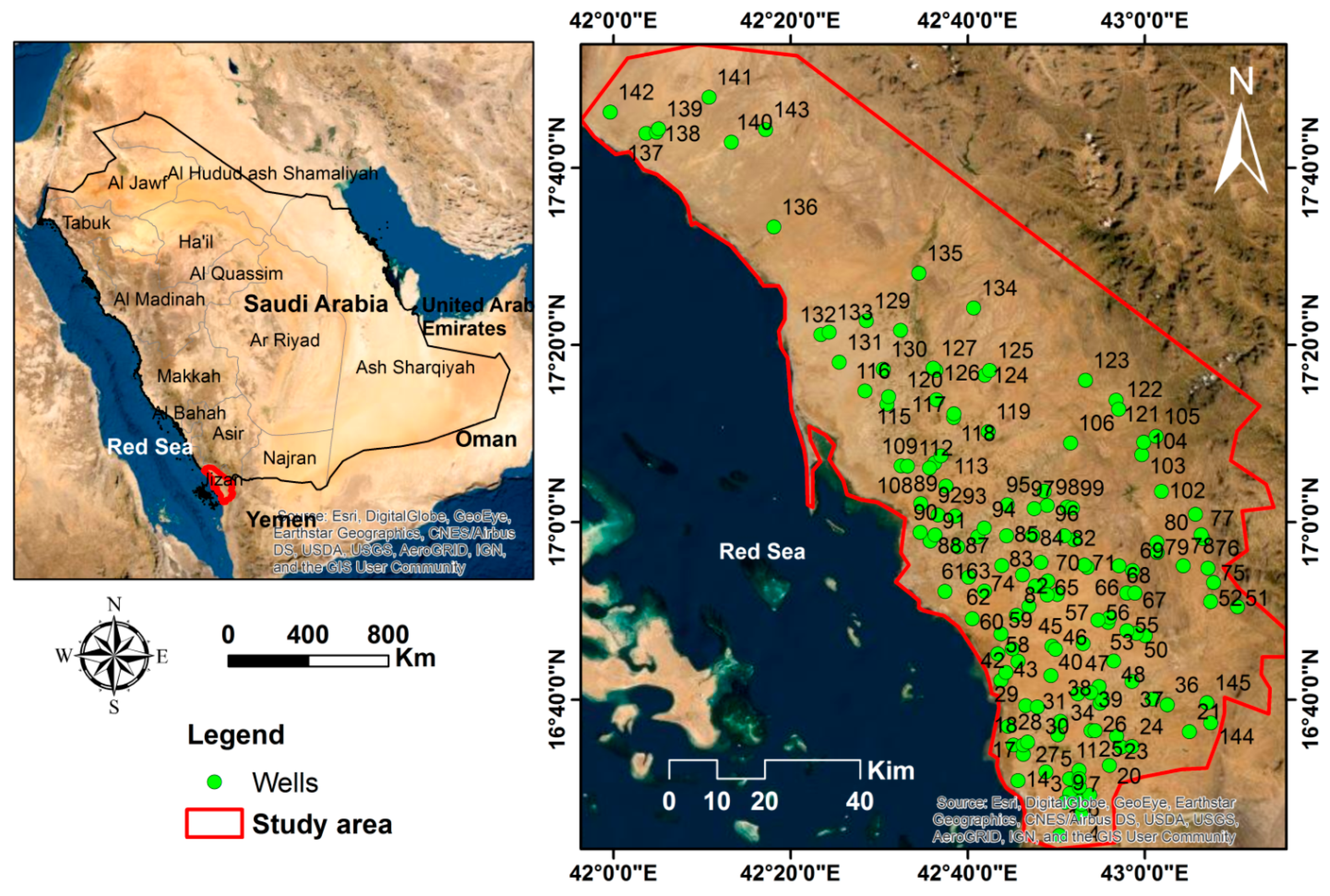
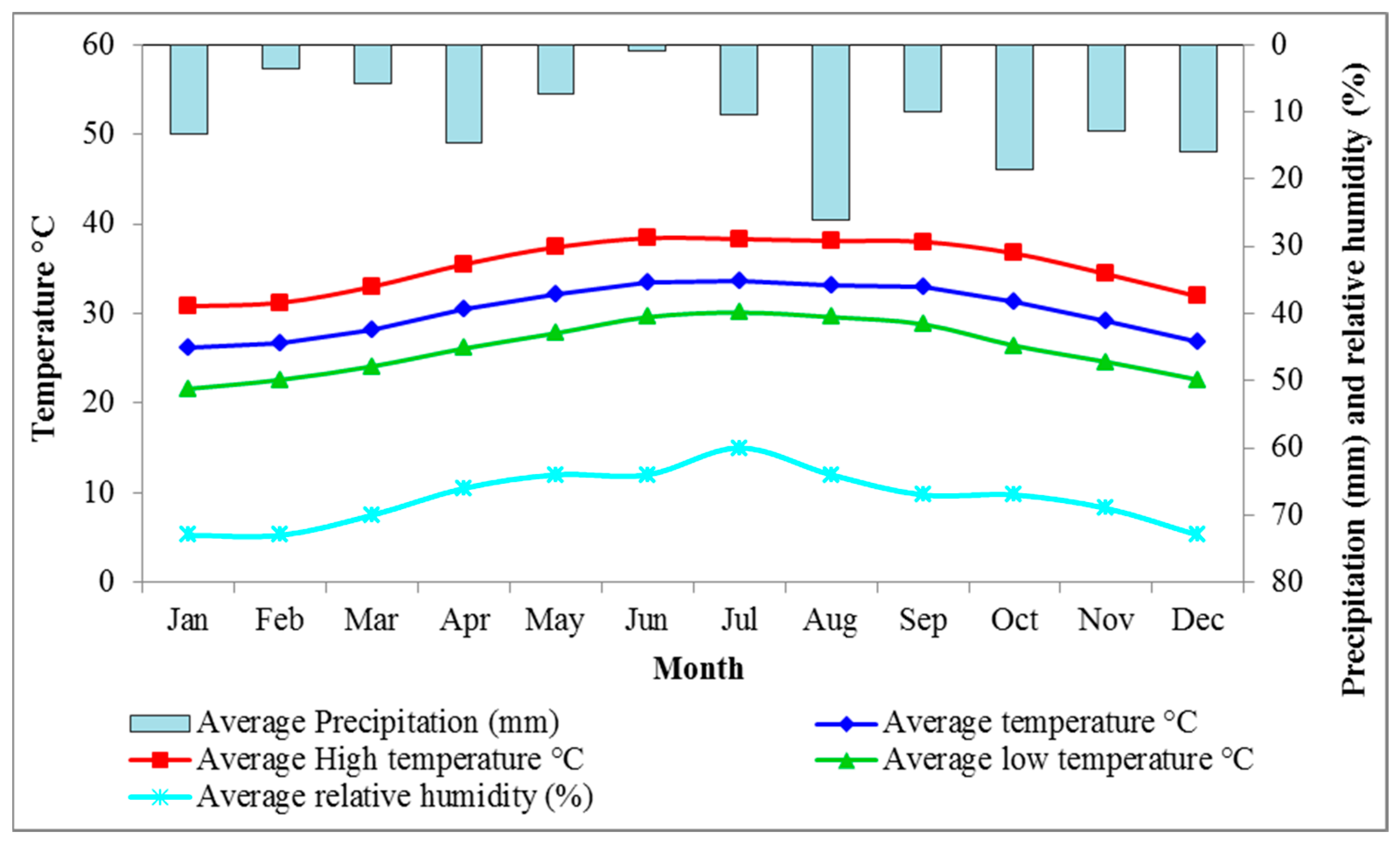
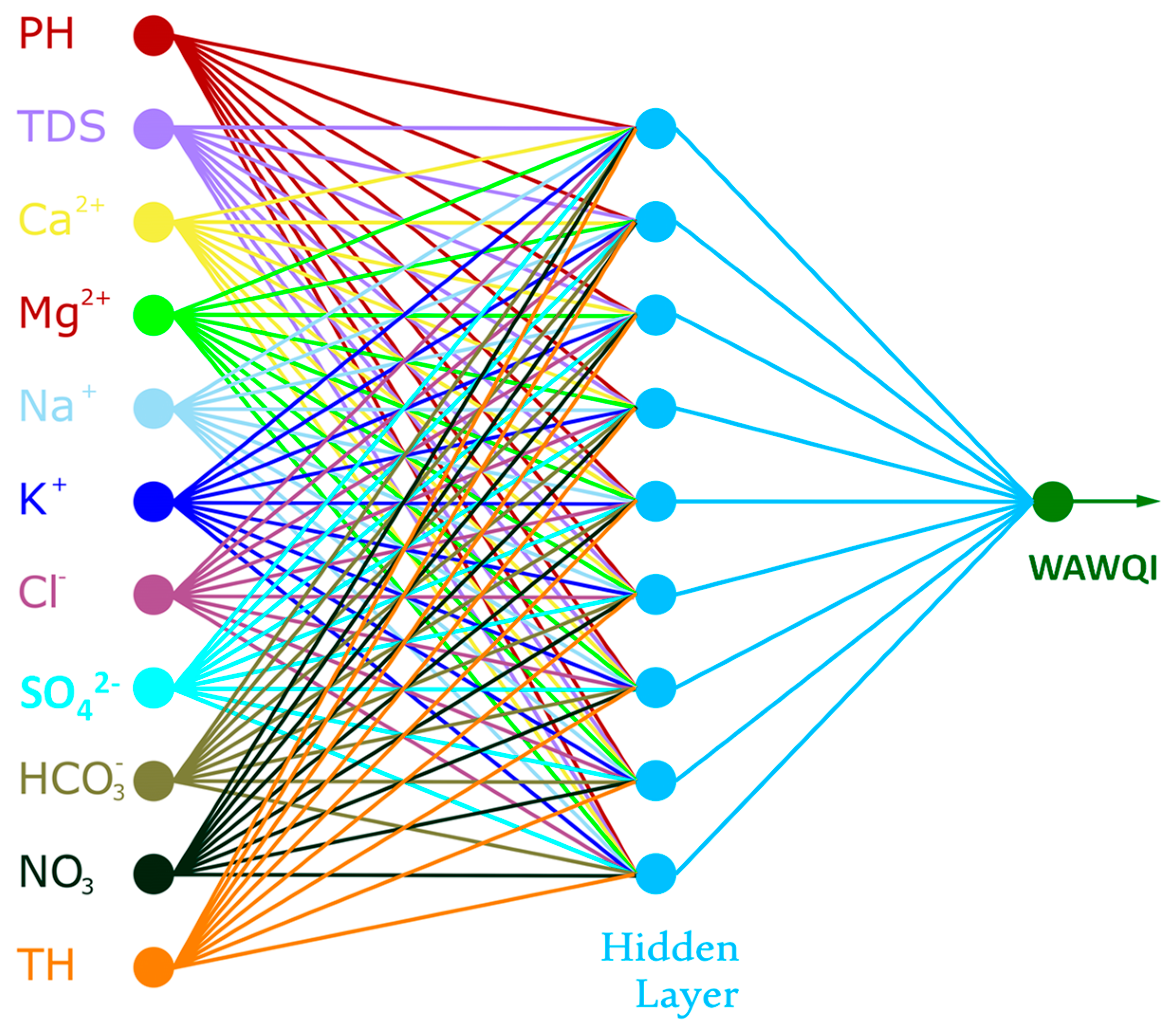

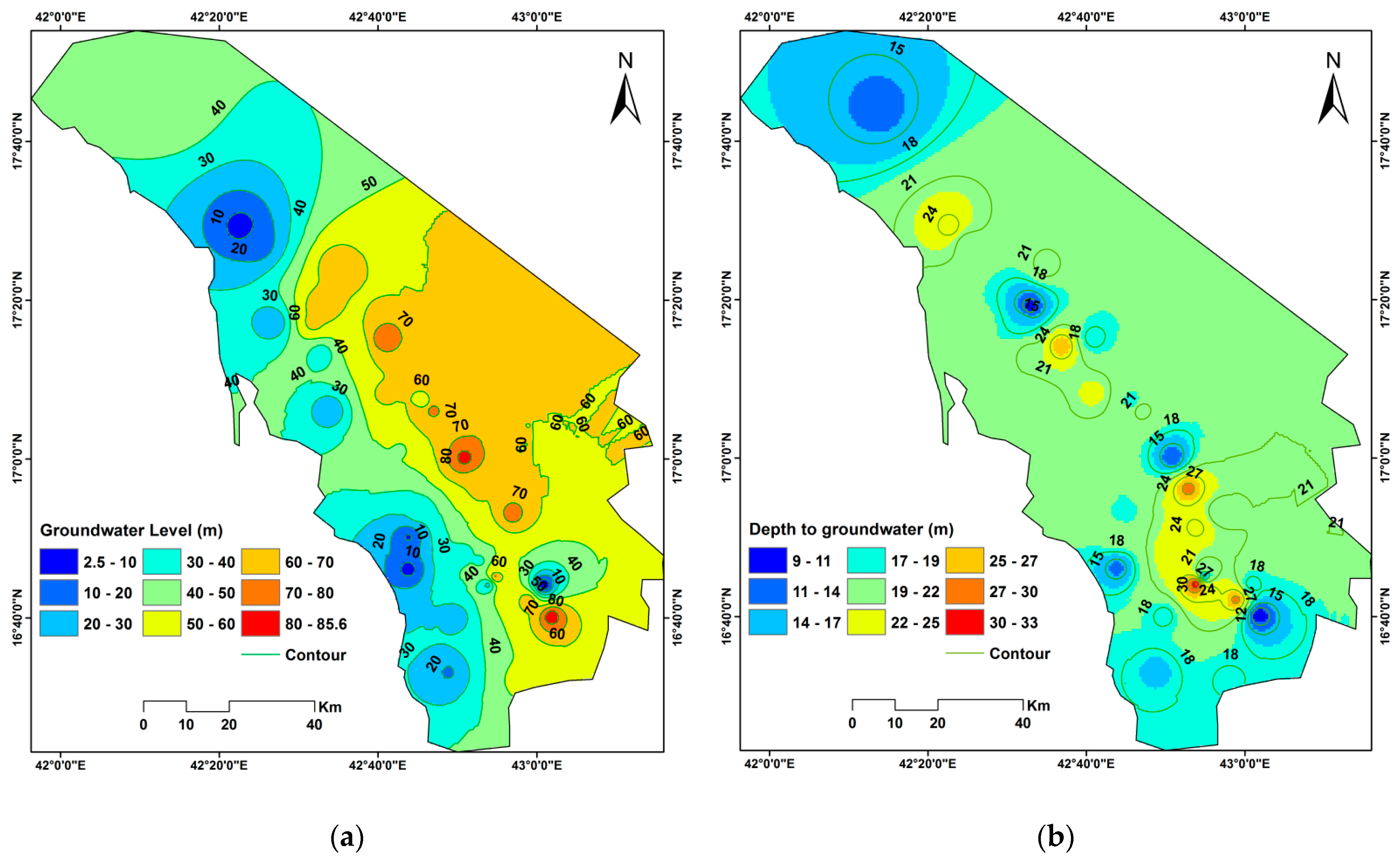
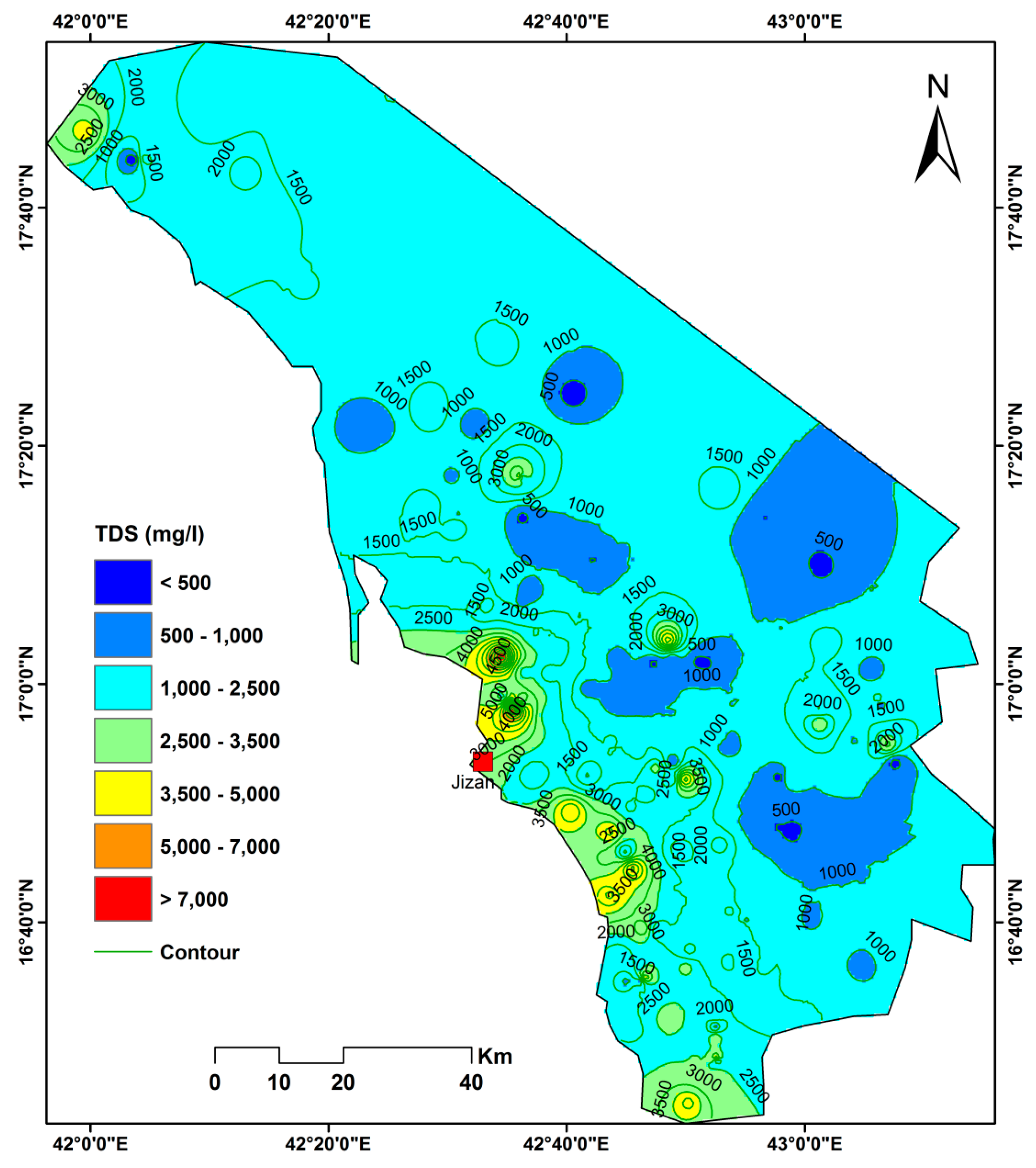

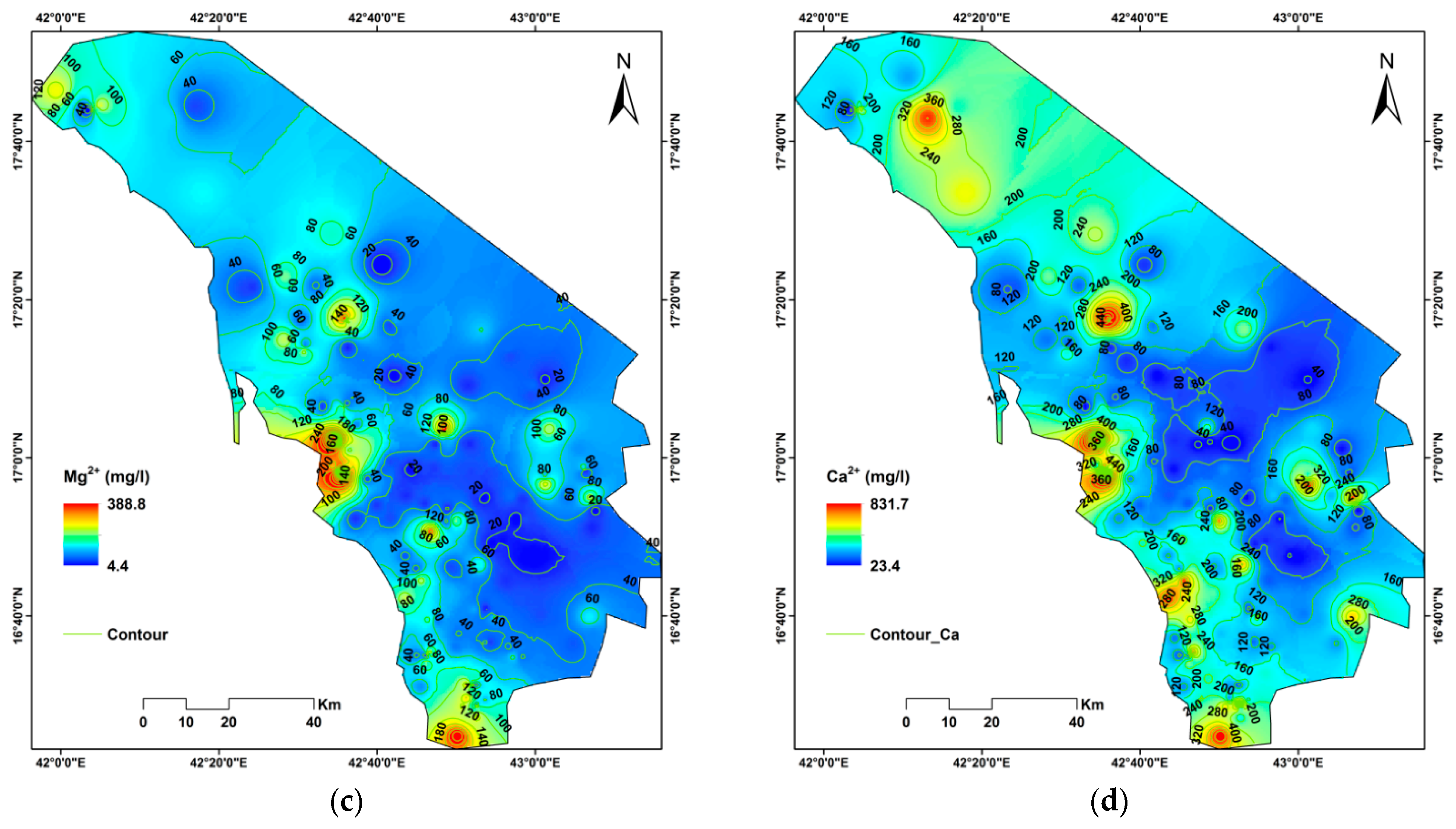
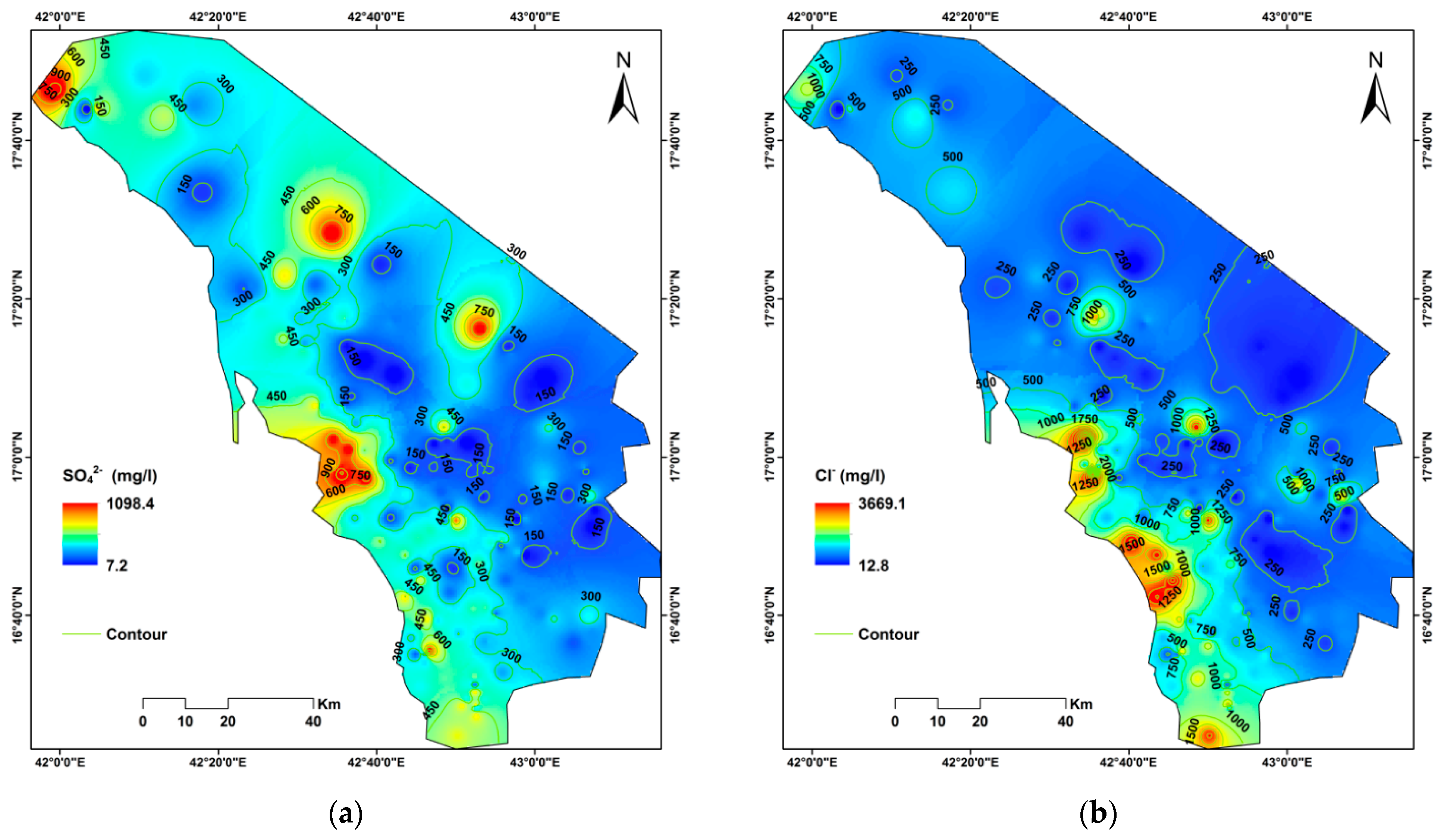

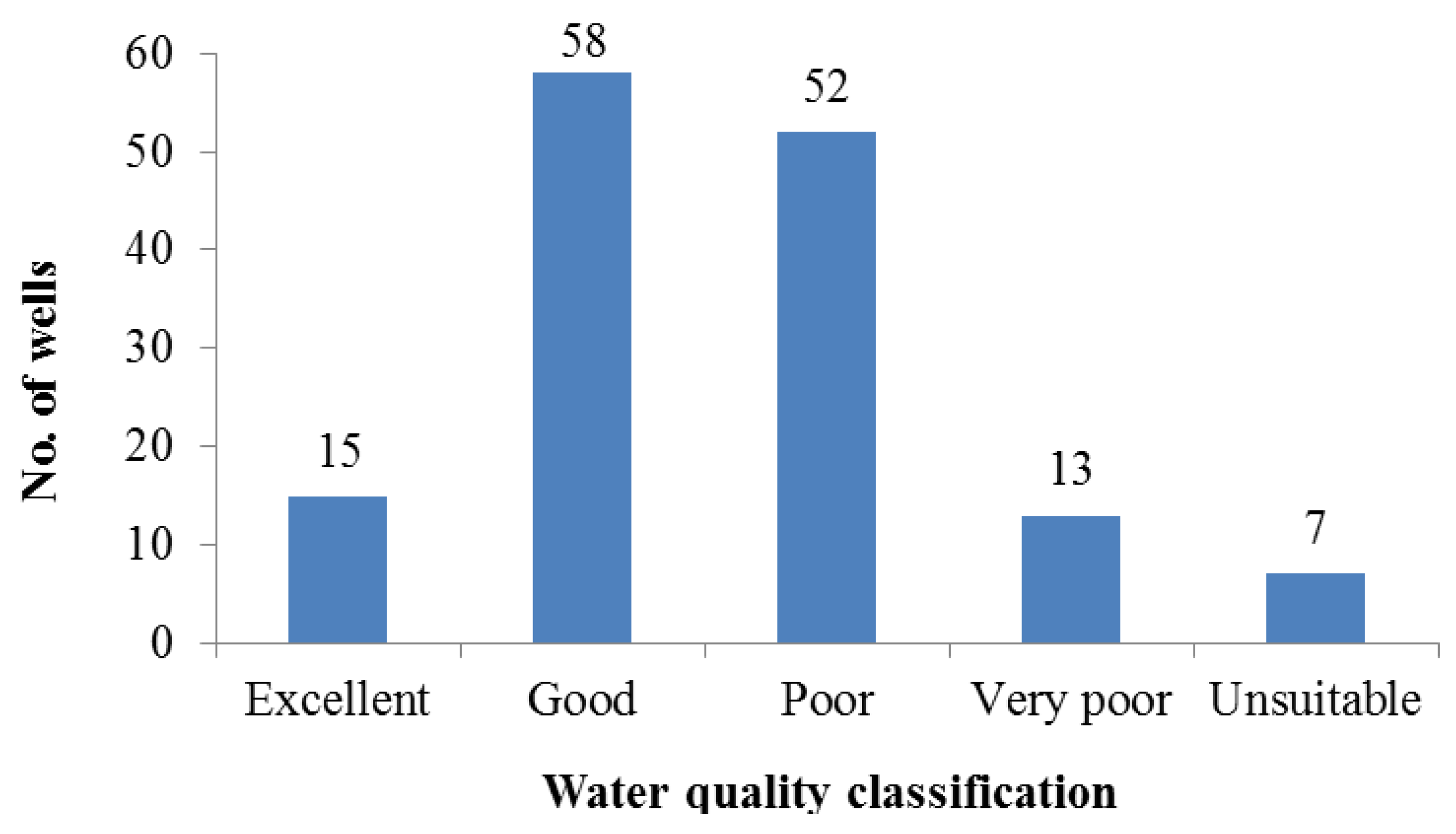
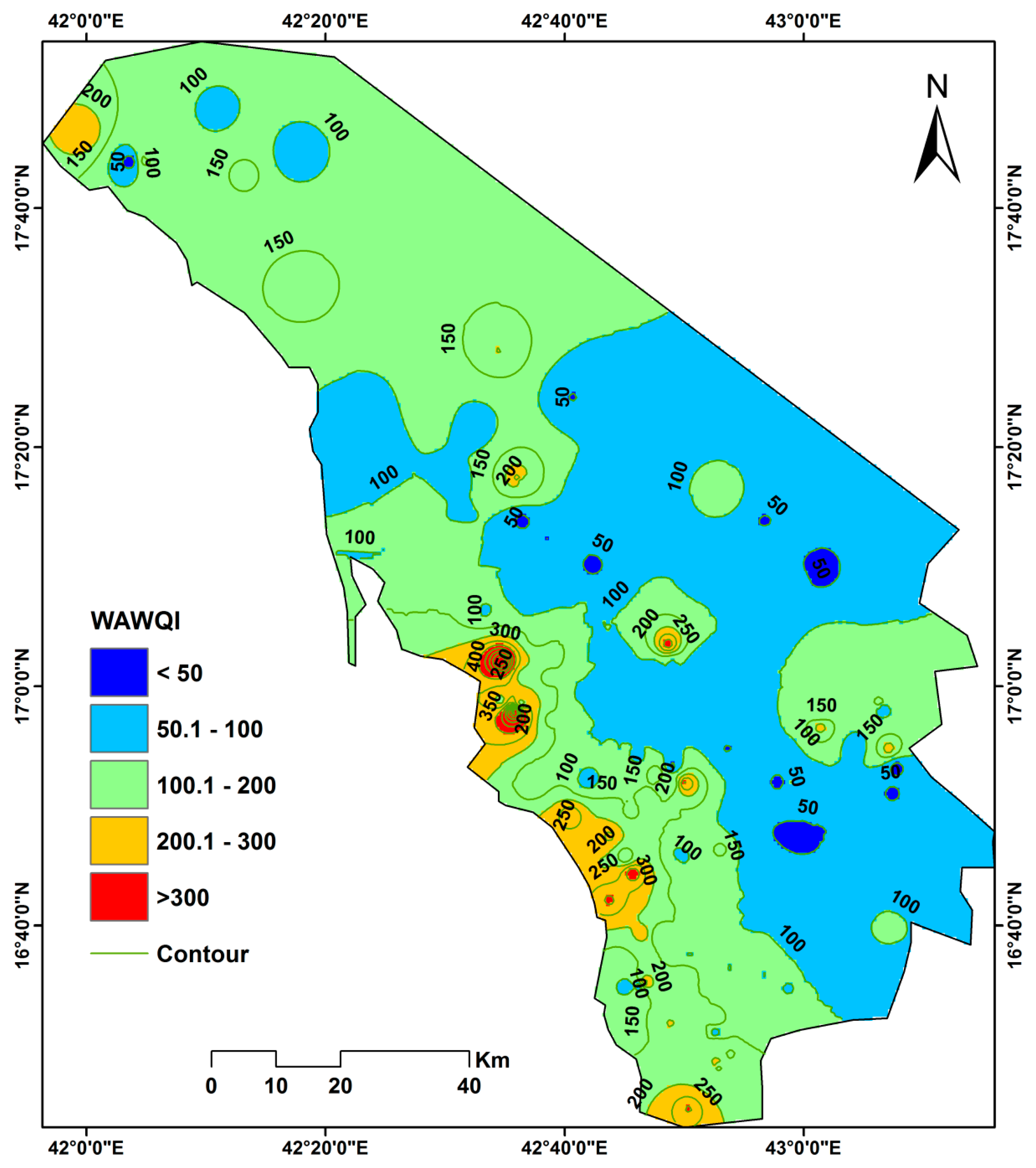
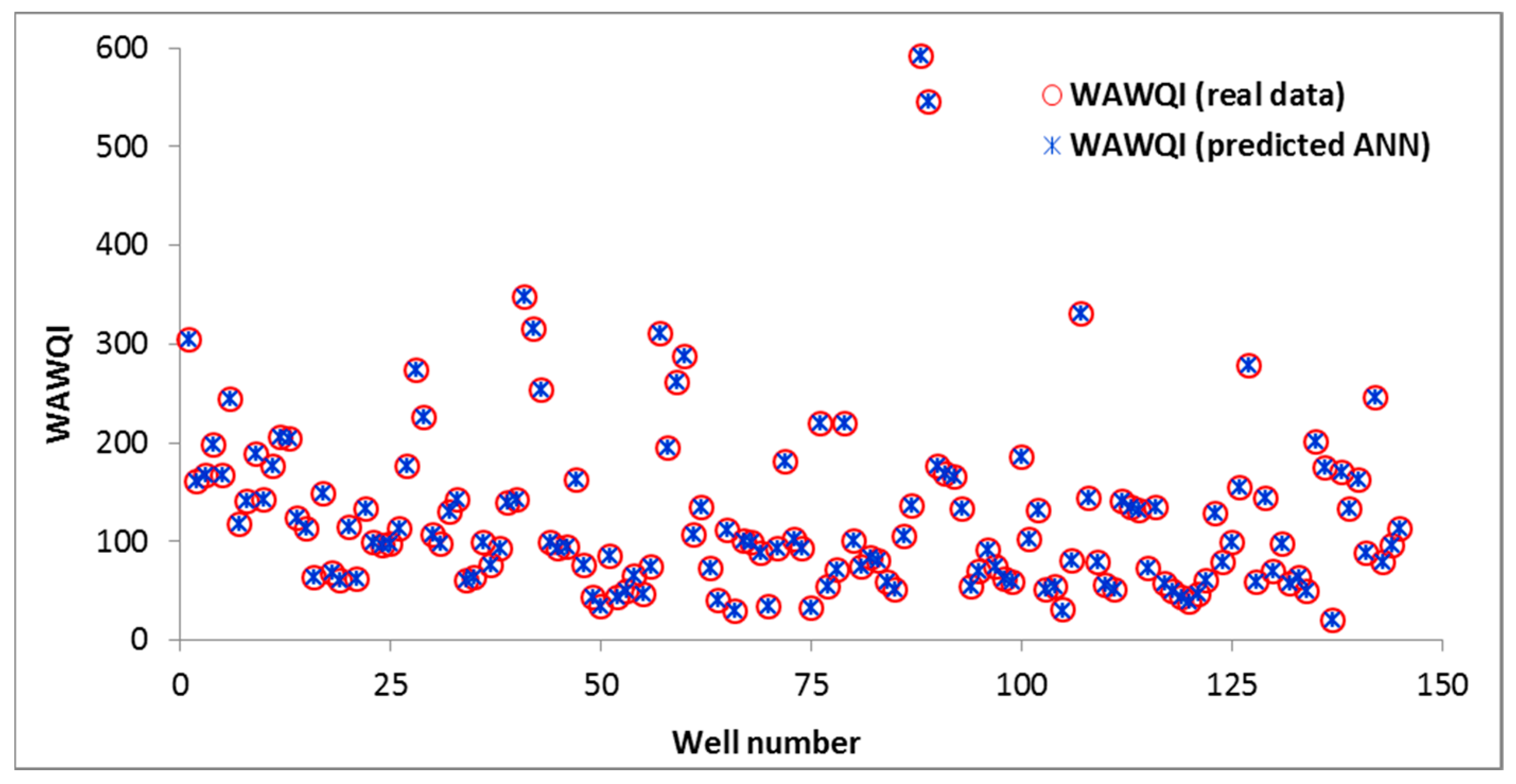
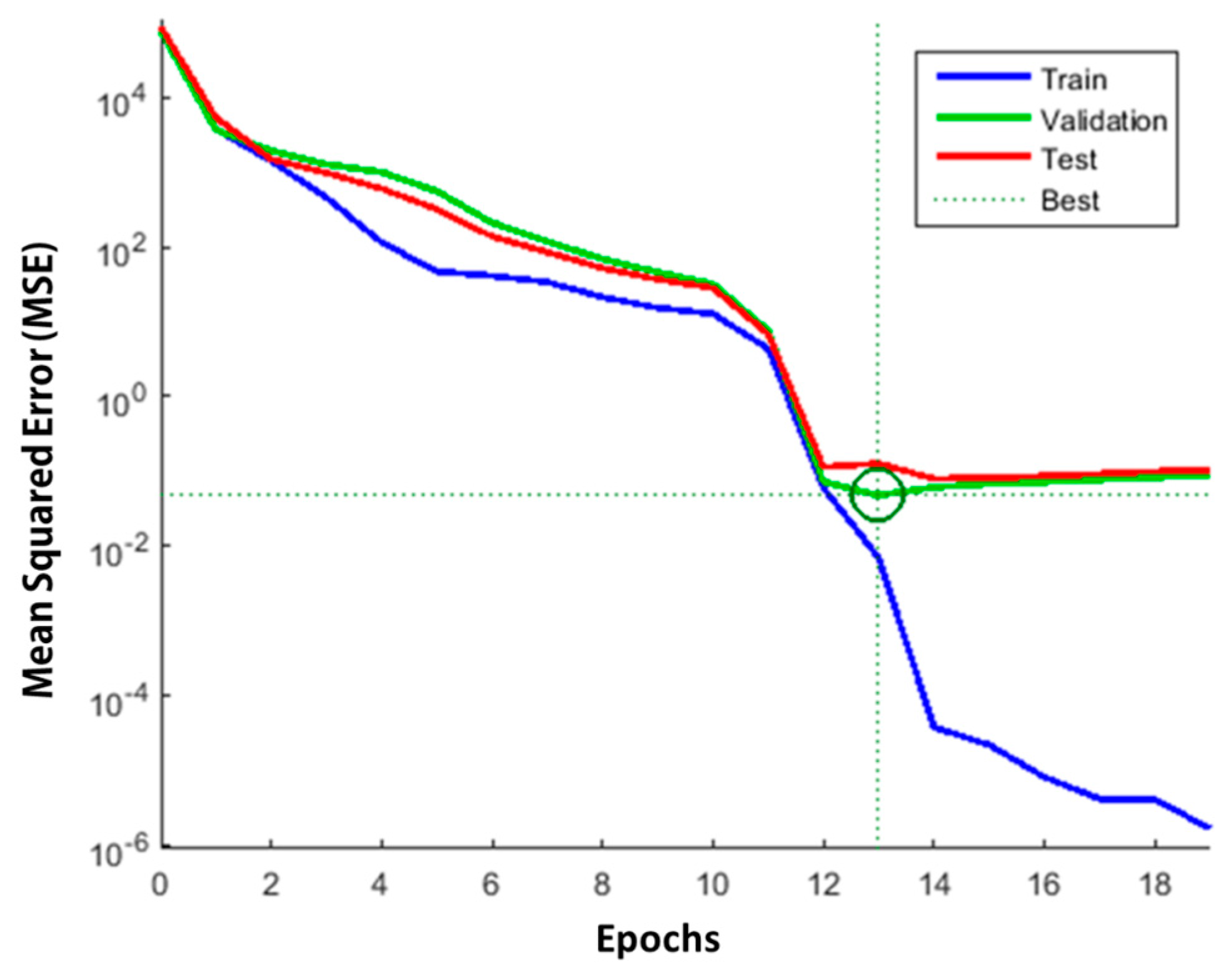
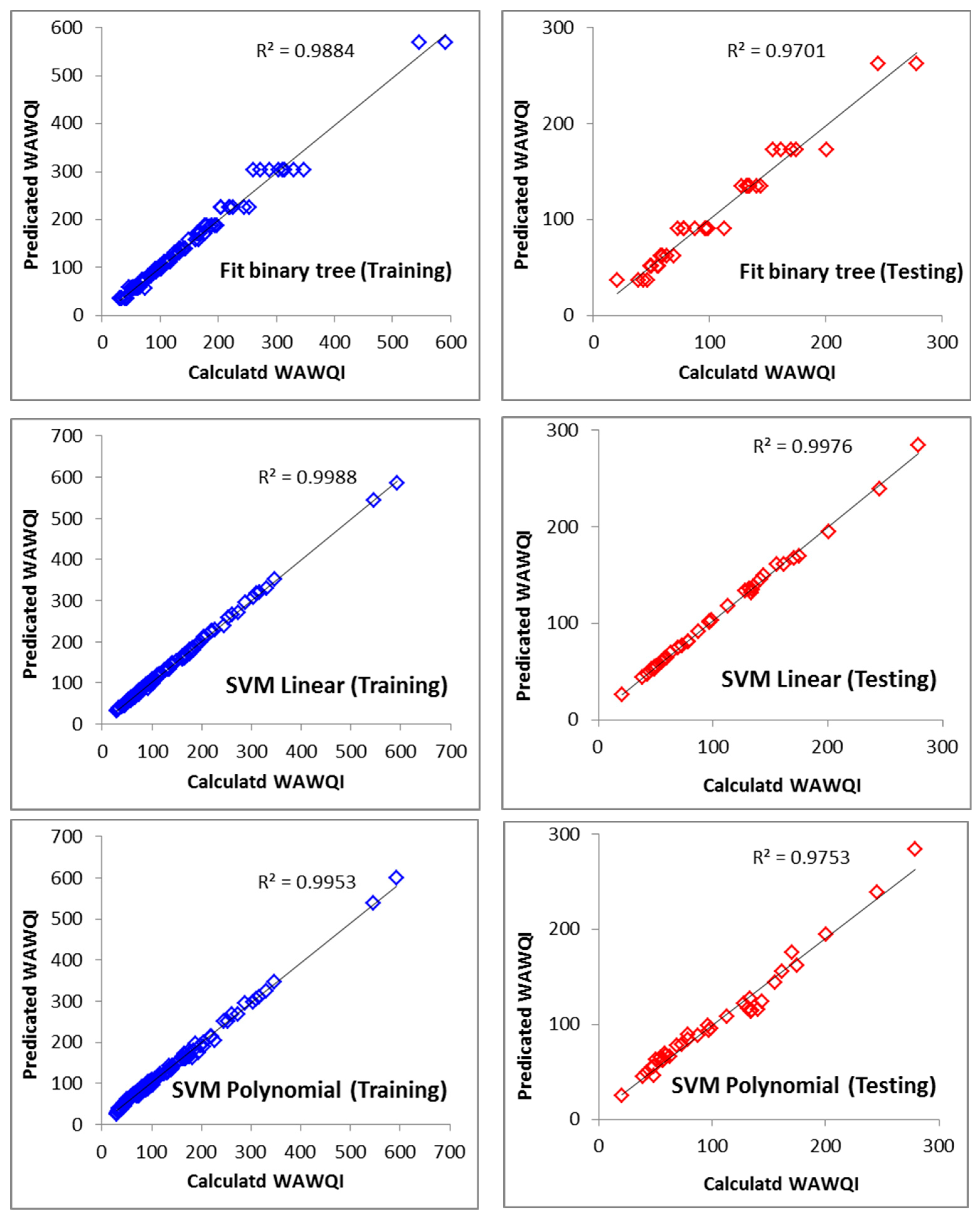
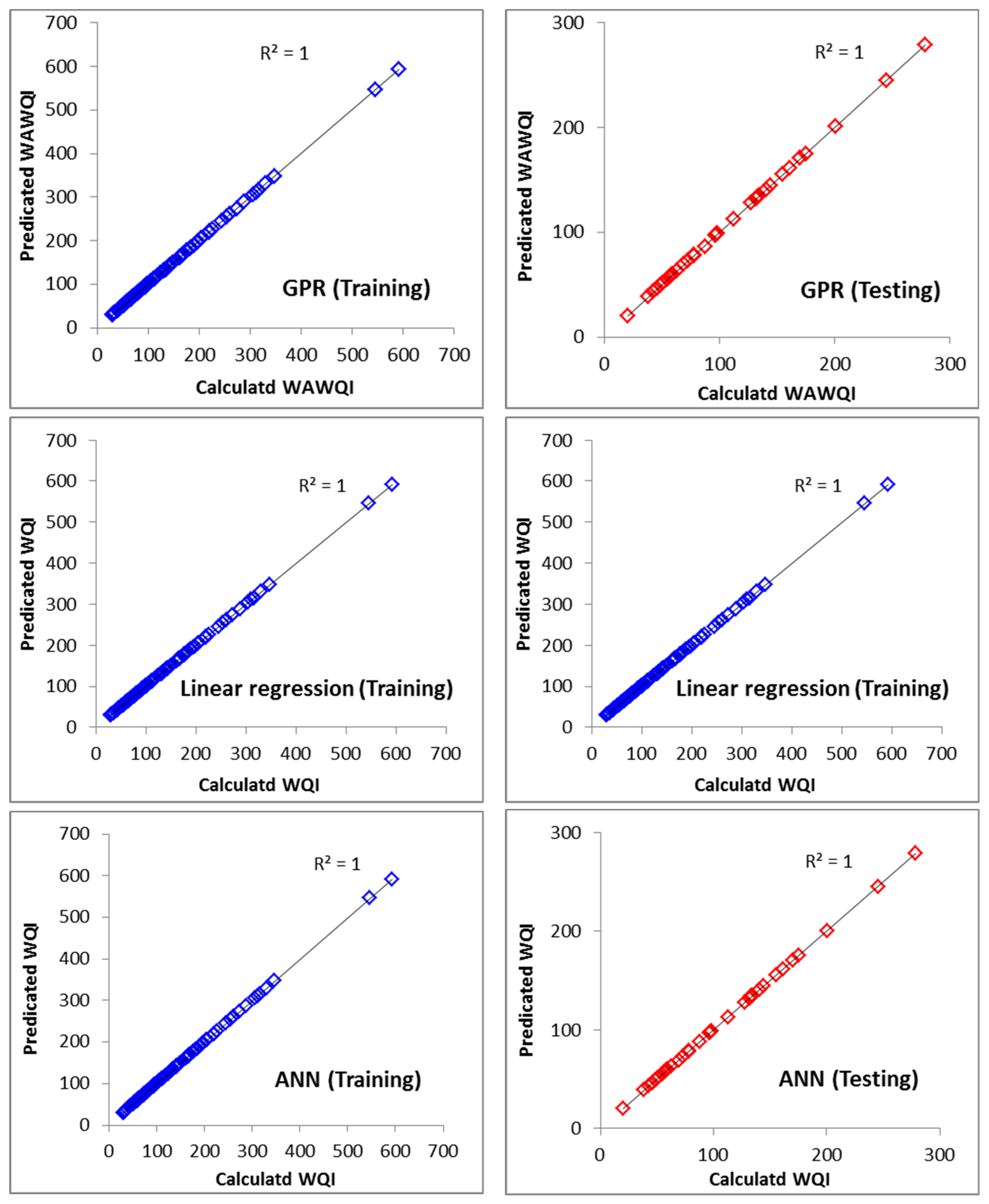
| Element | Min. | Max. | Average | Standard Deviation | WHO Guidelines [44] |
|---|---|---|---|---|---|
| pH | 6.3 | 8.7 | 7.7 | 0.3 | 7 |
| TDS (mg/L) | 128.0 | 8320.0 | 1709.6 | 1293.0 | 1000 |
| TH (mg/L) | 90.6 | 3676.6 | 640.8 | 526.7 | 500 |
| Ca2+ (mg/L) | 23.5 | 831.7 | 157.7 | 131.6 | 200 |
| Mg2+ (mg/L) | 4.4 | 388.8 | 60.0 | 55.9 | 30 |
| Na+ (mg/L) | 1.6 | 1291.4 | 307.6 | 276.3 | 200 |
| K+ (mg/L) | 1.2 | 188.5 | 12.4 | 27.6 | 12 |
| Cl− (mg/L) | 12.8 | 3669.1 | 571.6 | 602.3 | 250 |
| HCO3− (mg/L) | 9.2 | 518.1 | 217.5 | 89.4 | 350 |
| SO42− (mg/L) | 7.2 | 1098.5 | 319.8 | 221.9 | 350 |
| NO3− (mg/L) | 0.00 | 34.1 | 1.8 | 4.4 | 50 |
| Parameters | Weight (wi) | Relative Weight (Wi) |
|---|---|---|
| pH | 4 | 0.100 |
| TDS | 5 | 0.125 |
| TH | 3 | 0.075 |
| Ca2+ | 3 | 0.075 |
| Mg2+ | 3 | 0.075 |
| Na+ | 4 | 0.100 |
| K+ | 2 | 0.050 |
| Cl− | 5 | 0.125 |
| HCO3− | 1 | 0.025 |
| SO42− | 5 | 0.125 |
| NO3− | 5 | 0.125 |
| WAWQI | Water Type |
|---|---|
| <50 | Excellent |
| 50–100 | Good |
| 100.1–200 | Poor |
| 200.1–300 | Very poor |
| >300.1 | Unsuitable |
| Variable | Mean | SE Mean | StDev | Minimum | Q1 | Median | Q3 | Maximum |
|---|---|---|---|---|---|---|---|---|
| pH | 7.66 | 0.03 | 0.31 | 6.33 | 7.48 | 7.67 | 7.82 | 8.68 |
| TDS | 1710 | 108 | 1298 | 128 | 803 | 1408 | 2128 | 8320 |
| TH | 640.8 | 43.9 | 528.5 | 90.6 | 303.4 | 473.2 | 864.0 | 3676.6 |
| Ca2+ | 157.7 | 11.0 | 132.0 | 23.4 | 73.5 | 116.6 | 193.0 | 831.7 |
| Mg2+ | 60.02 | 4.66 | 56.08 | 4.37 | 27.03 | 39.00 | 83.11 | 388.80 |
| Na+ | 307.6 | 23.0 | 277.3 | 1.6 | 116.4 | 242.1 | 365.1 | 1291.3 |
| K+ | 12.44 | 2.30 | 27.68 | 1.17 | 3.52 | 5.47 | 7.62 | 188.46 |
| Cl− | 571.6 | 50.2 | 604.4 | 12.8 | 173.4 | 427.9 | 691.6 | 3669.1 |
| HCO3− | 217.45 | 7.45 | 89.69 | 9.15 | 151.94 | 206.25 | 266.05 | 518.06 |
| SO42– | 319.8 | 18.5 | 222.7 | 7.2 | 141.2 | 287.2 | 427.5 | 1098.4 |
| NO3− | 1.837 | 0.363 | 4.374 | 0.000 | 0.330 | 0.800 | 1.465 | 34.140 |
| WAWQI | 125.41 | 7.26 | 87.40 | 20.30 | 64.61 | 99.46 | 161.33 | 592.31 |
| pH | TDS | TH | Ca2+ | Mg2+ | Na+ | K+ | Cl− | HCO3− | SO42– | NO3− | |
|---|---|---|---|---|---|---|---|---|---|---|---|
| pH | 1 | ||||||||||
| TDS | −0.098 | 1 | |||||||||
| TH | −0.203 | 0.873 | 1 | ||||||||
| Ca2+ | −0.198 | 0.837 | 0.961 | 1 | |||||||
| Mg2+ | −0.182 | 0.803 | 0.918 | 0.771 | 1 | ||||||
| Na+ | 0.014 | 0.906 | 0.586 | 0.567 | 0.533 | 1 | |||||
| K+ | −0.004 | −0.045 | 0.003 | −0.004 | 0.012 | −0.108 | 1 | ||||
| Cl− | −0.053 | 0.977 | 0.847 | 0.818 | 0.770 | 0.891 | −0.056 | 1 | |||
| HCO3− | −0.220 | 0.007 | 0.021 | 0.011 | 0.033 | −0.004 | 0.045 | −0.102 | 1 | ||
| SO42– | −0.140 | 0.753 | 0.675 | 0.629 | 0.648 | 0.668 | 0.008 | 0.610 | 0.091 | 1 | |
| NO3− | −0.273 | 0.152 | 0.261 | 0.289 | 0.185 | 0.030 | 0.009 | 0.091 | 0.235 | 0.253 | 1 |
| Estimate | SE | p Value | |
|---|---|---|---|
| Intercept | −0.005731 | 0.0070781 | 0.41958 |
| pH | 1.4292 | 0.0008888 | <0.00000 |
| TDS | 0.012481 | 1.18 × 10−5 | <0.00000 |
| TH | 0.069523 | 0.018668 | 0.0002884 |
| Ca2+ | −0.098639 | 0.046613 | 0.036195 |
| Mg2+ | 0.025649 | 0.076817 | 0.73898 |
| Na+ | 0.050002 | 1.91 × 10−5 | <0.00000 |
| K+ | 0.41667 | 1.09 × 10−5 | 0 |
| Cl− | 0.050032 | 1.73 × 10−5 | <0.00000 |
| HCO3− | 0.007165 | 1.02 × 10−5 | <0.00000 |
| SO42– | 0.03574 | 1.30 × 10−5 | <0.00000 |
| NO3− | 0.24998 | 6.28 × 10−5 | 0 |
| Model/Indices | ME | MAE | RMSE | MAPE % | R | R2 | |
|---|---|---|---|---|---|---|---|
| Fit binary tree | Training | 0.00 | 6.066 | 10.085 | 4.920 | 0.9884 | 0.9942 |
| Testing | 0.00 | 7.723 | 10.222 | 8.772 | 0.9701 | 0.9849 | |
| SVM (linear) | Training | 1.920 | 3.388 | 3.825 | 3.380 | 0.9988 | 0.9994 |
| Testing | 3.185 | 4.469 | 4.688 | 5.642 | 0.9976 | 0.9988 | |
| SVM (polynomial kernel) | Training | −0.234 | 6.424 | 8.144 | 5.453 | 0.9953 | 0.9976 |
| Testing | −1.078 | 8.302 | 10.040 | 9.343 | 0.9753 | 0.9876 | |
| Gaussian process regression (GPR) | Training | 0.00 | 0.1935 | 0.2552 | 0.234 | 1.00 | 1.00 |
| Testing | 0.00 | 0.2529 | 0.326 | 0.391 | 1.00 | 1.00 | |
| Linear regression (stepwise) | Training | 0.00 | 0.0023 | 0.0028 | 0.0025 | 1.00 | 1.00 |
| Testing | 0.00 | 0.0024 | 0.0029 | 0.0014 | 1.00 | 1.00 | |
| ANN | Training | 0.088 | 0.088 | 0.0884 | 0.0969 | 1.00 | 1.00 |
| Testing | 0.074 | 0.074 | 0.075 | 0.0982 | 1.00 | 1.00 | |
| No. of Variables | Variables | MSE | R2 | Adjusted R2 | Akaike’s AIC | Schwarz’s SBC | Amemiya’s PC |
|---|---|---|---|---|---|---|---|
| 1 | NO3 | 7467.34 | 0.02 | 0.023 | 1295.139 | 1301.092 | 0.984 |
| 2 | SO4/NO3 | 3356.68 | 0.56 | 0.561 | 1180.181 | 1189.112 | 0.445 |
| 3 | HCO3/SO4/NO3 | 3342.15 | 0.57 | 0.563 | 1180.527 | 1192.434 | 0.446 |
| 4 | Cl/HCO3/SO4/NO3 | 197.359 | 0.975 | 0.974 | 771.240 | 786.124 | 0.027 |
| 5 | K/Cl/HCO3/SO4/NO3 | 60.957 | 0.992 | 0.992 | 601.848 | 619.708 | 0.008 |
| 6 | Na/K/Cl/HCO3/SO4/NO3 | 17.220 | 0.998 | 0.998 | 419.503 | 440.340 | 0.002 |
| 7 | Mg/Na/K/Cl/HCO3/SO4/NO3 | 1.773 | 1.000 | 1.000 | 90.825 | 114.639 | 0.000 |
| 8 | Ca/Mg/Na/K/Cl/HCO3/SO4/NO3 | 0.184 | 1.000 | 1.000 | −236.474 | −209.684 | 0.000 |
| 9 | TH/Ca/Na/K/Cl/HCO3/SO4/NO3 | 0.184 | 1.000 | 1.000 | −236.474 | −209.684 | 0.000 |
| 10 | TDS/TH/Ca/Na/K/Cl/HCO3/SO4/NO3 | 0.161 | 1.000 | 1.000 | −255.097 | −225.330 | 0.000 |
| 11 | pH/TDS/TH/Ca/Na/K/Cl/HCO3/SO4/NO3 | 0.000 | 1.000 | 1.000 | 0.000 | 0.000 | 0.000 |
Disclaimer/Publisher’s Note: The statements, opinions and data contained in all publications are solely those of the individual author(s) and contributor(s) and not of MDPI and/or the editor(s). MDPI and/or the editor(s) disclaim responsibility for any injury to people or property resulting from any ideas, methods, instructions or products referred to in the content. |
© 2023 by the authors. Licensee MDPI, Basel, Switzerland. This article is an open access article distributed under the terms and conditions of the Creative Commons Attribution (CC BY) license (https://creativecommons.org/licenses/by/4.0/).
Share and Cite
El-Rawy, M.; Batelaan, O.; Alshehri, F.; Almadani, S.; Ahmed, M.S.; Elbeltagi, A. An Integrated GIS and Machine-Learning Technique for Groundwater Quality Assessment and Prediction in Southern Saudi Arabia. Water 2023, 15, 2448. https://doi.org/10.3390/w15132448
El-Rawy M, Batelaan O, Alshehri F, Almadani S, Ahmed MS, Elbeltagi A. An Integrated GIS and Machine-Learning Technique for Groundwater Quality Assessment and Prediction in Southern Saudi Arabia. Water. 2023; 15(13):2448. https://doi.org/10.3390/w15132448
Chicago/Turabian StyleEl-Rawy, Mustafa, Okke Batelaan, Fahad Alshehri, Sattam Almadani, Mohamed S. Ahmed, and Ahmed Elbeltagi. 2023. "An Integrated GIS and Machine-Learning Technique for Groundwater Quality Assessment and Prediction in Southern Saudi Arabia" Water 15, no. 13: 2448. https://doi.org/10.3390/w15132448
APA StyleEl-Rawy, M., Batelaan, O., Alshehri, F., Almadani, S., Ahmed, M. S., & Elbeltagi, A. (2023). An Integrated GIS and Machine-Learning Technique for Groundwater Quality Assessment and Prediction in Southern Saudi Arabia. Water, 15(13), 2448. https://doi.org/10.3390/w15132448








